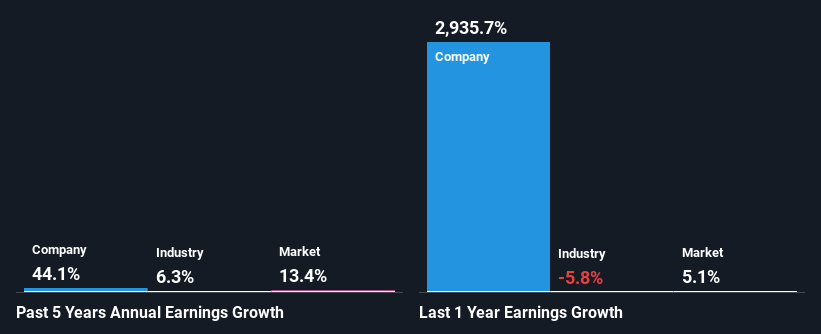Is TAS Offshore Berhad's (KLSE:TAS) Recent Stock Performance Tethered To Its Strong Fundamentals?
TAS Offshore Berhad's (KLSE:TAS) stock is up by a considerable 36% over the past three months. Given the company's impressive performance, we decided to study its financial indicators more closely as a company's financial health over the long-term usually dictates market outcomes. Specifically, we decided to study TAS Offshore Berhad's ROE in this article.
Return on equity or ROE is a key measure used to assess how efficiently a company's management is utilizing the company's capital. Put another way, it reveals the company's success at turning shareholder investments into profits.
See our latest analysis for TAS Offshore Berhad
How Do You Calculate Return On Equity?
The formula for return on equity is:
Return on Equity = Net Profit (from continuing operations) ÷ Shareholders' Equity
So, based on the above formula, the ROE for TAS Offshore Berhad is:
25% = RM26m ÷ RM104m (Based on the trailing twelve months to February 2024).
The 'return' is the yearly profit. One way to conceptualize this is that for each MYR1 of shareholders' capital it has, the company made MYR0.25 in profit.
What Has ROE Got To Do With Earnings Growth?
Thus far, we have learned that ROE measures how efficiently a company is generating its profits. Depending on how much of these profits the company reinvests or "retains", and how effectively it does so, we are then able to assess a company’s earnings growth potential. Generally speaking, other things being equal, firms with a high return on equity and profit retention, have a higher growth rate than firms that don’t share these attributes.
TAS Offshore Berhad's Earnings Growth And 25% ROE
To begin with, TAS Offshore Berhad has a pretty high ROE which is interesting. Additionally, the company's ROE is higher compared to the industry average of 7.5% which is quite remarkable. As a result, TAS Offshore Berhad's exceptional 44% net income growth seen over the past five years, doesn't come as a surprise.
We then compared TAS Offshore Berhad's net income growth with the industry and we're pleased to see that the company's growth figure is higher when compared with the industry which has a growth rate of 6.3% in the same 5-year period.
The basis for attaching value to a company is, to a great extent, tied to its earnings growth. It’s important for an investor to know whether the market has priced in the company's expected earnings growth (or decline). By doing so, they will have an idea if the stock is headed into clear blue waters or if swampy waters await. One good indicator of expected earnings growth is the P/E ratio which determines the price the market is willing to pay for a stock based on its earnings prospects. So, you may want to check if TAS Offshore Berhad is trading on a high P/E or a low P/E, relative to its industry.
Is TAS Offshore Berhad Using Its Retained Earnings Effectively?
TAS Offshore Berhad's three-year median payout ratio to shareholders is 8.6%, which is quite low. This implies that the company is retaining 91% of its profits. So it looks like TAS Offshore Berhad is reinvesting profits heavily to grow its business, which shows in its earnings growth.
Besides, TAS Offshore Berhad has been paying dividends for at least ten years or more. This shows that the company is committed to sharing profits with its shareholders. Our latest analyst data shows that the future payout ratio of the company is expected to rise to 17% over the next three years. Therefore, the expected rise in the payout ratio explains why the company's ROE is expected to decline to 11% over the same period.
Conclusion
On the whole, we feel that TAS Offshore Berhad's performance has been quite good. Particularly, we like that the company is reinvesting heavily into its business, and at a high rate of return. Unsurprisingly, this has led to an impressive earnings growth. That being so, according to the latest industry analyst forecasts, the company's earnings are expected to shrink in the future. To know more about the latest analysts predictions for the company, check out this visualization of analyst forecasts for the company.
Have feedback on this article? Concerned about the content? Get in touch with us directly. Alternatively, email editorial-team (at) simplywallst.com.
This article by Simply Wall St is general in nature. We provide commentary based on historical data and analyst forecasts only using an unbiased methodology and our articles are not intended to be financial advice. It does not constitute a recommendation to buy or sell any stock, and does not take account of your objectives, or your financial situation. We aim to bring you long-term focused analysis driven by fundamental data. Note that our analysis may not factor in the latest price-sensitive company announcements or qualitative material. Simply Wall St has no position in any stocks mentioned.
Have feedback on this article? Concerned about the content? Get in touch with us directly. Alternatively, email editorial-team@simplywallst.com

 Yahoo Finanzas
Yahoo Finanzas 
